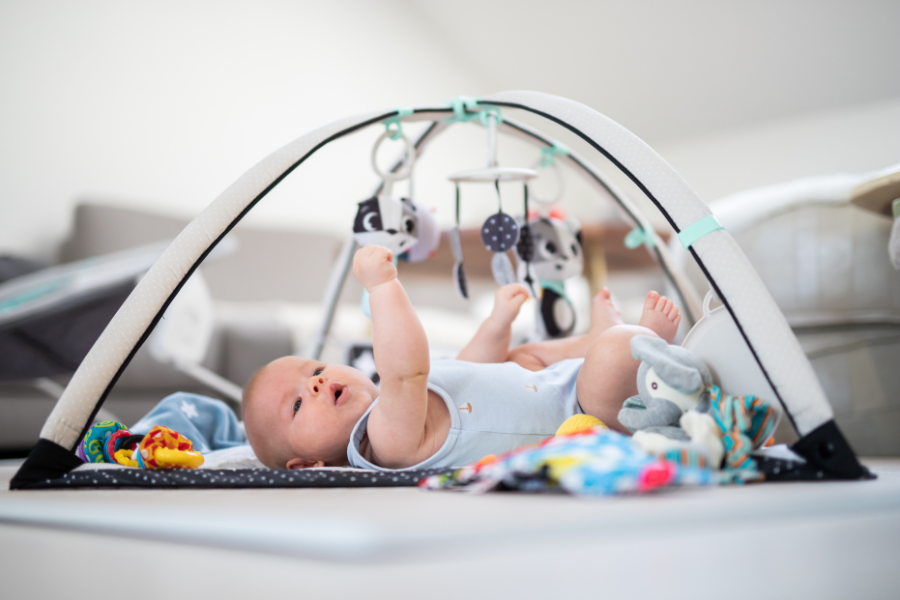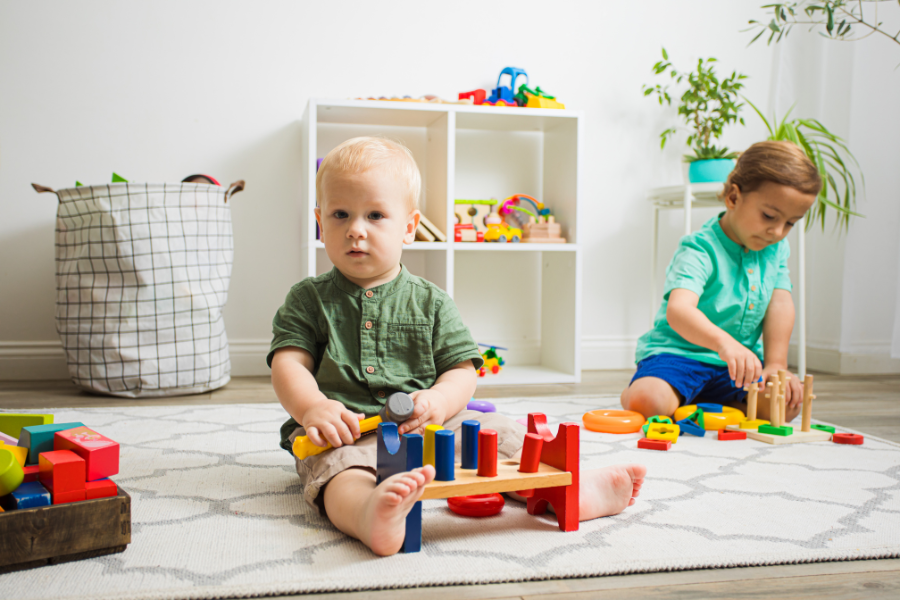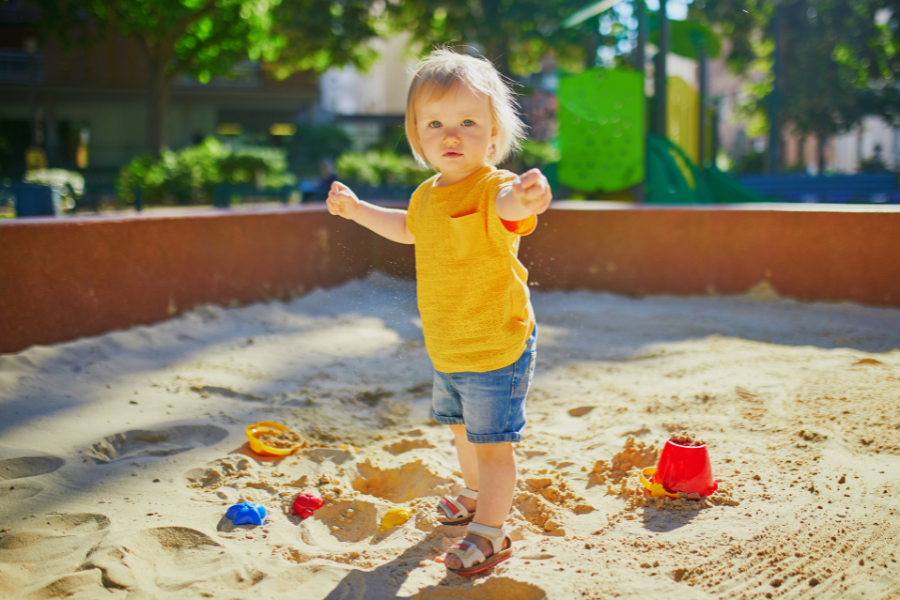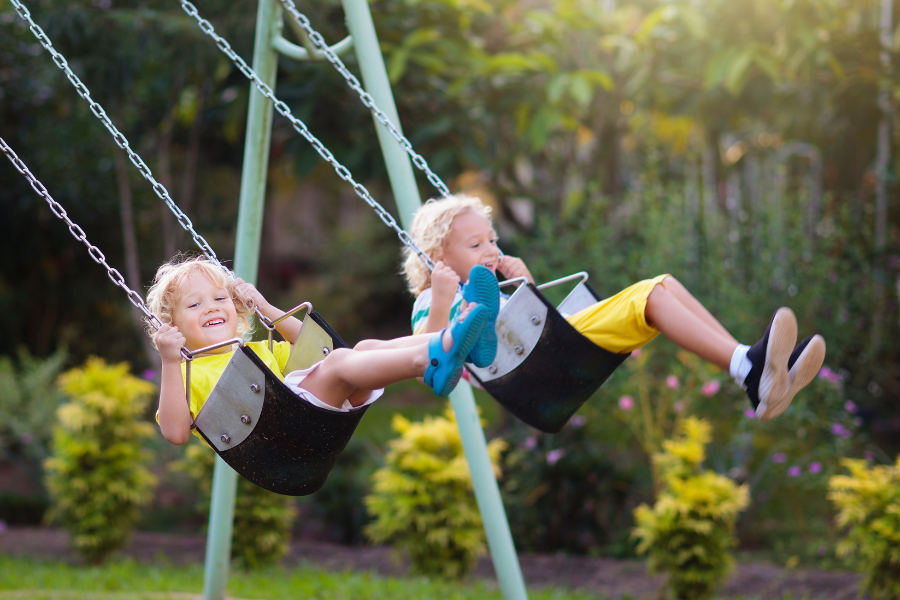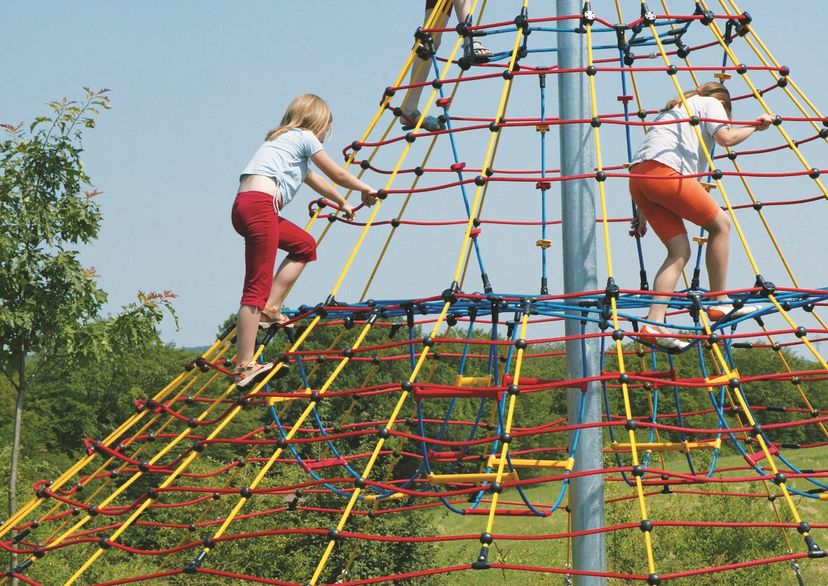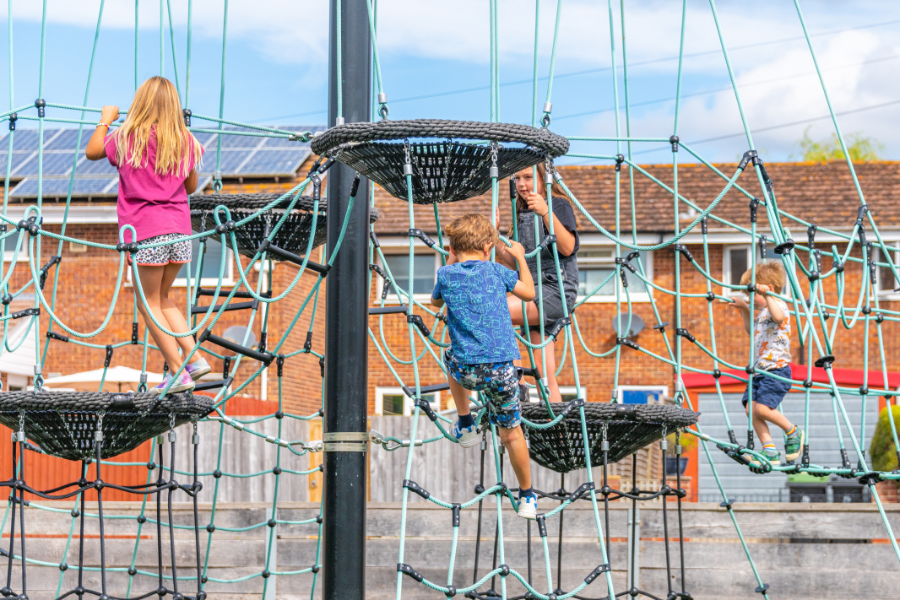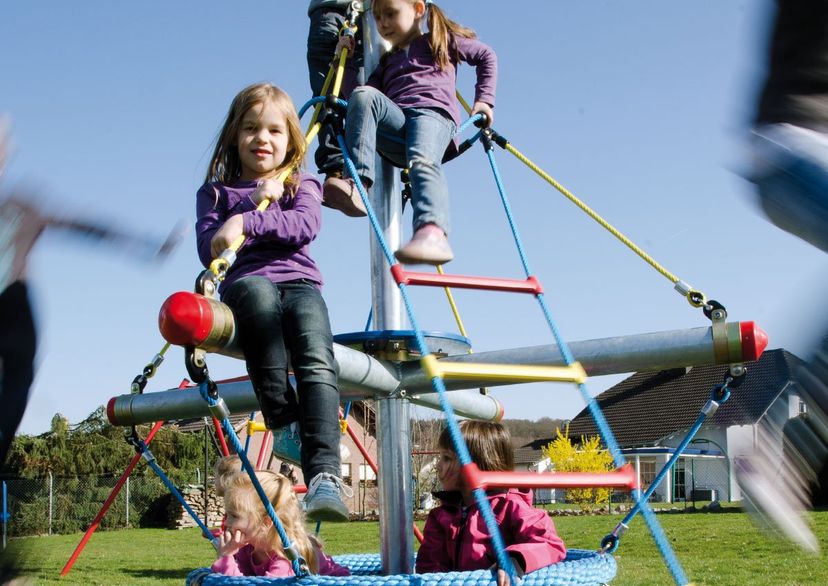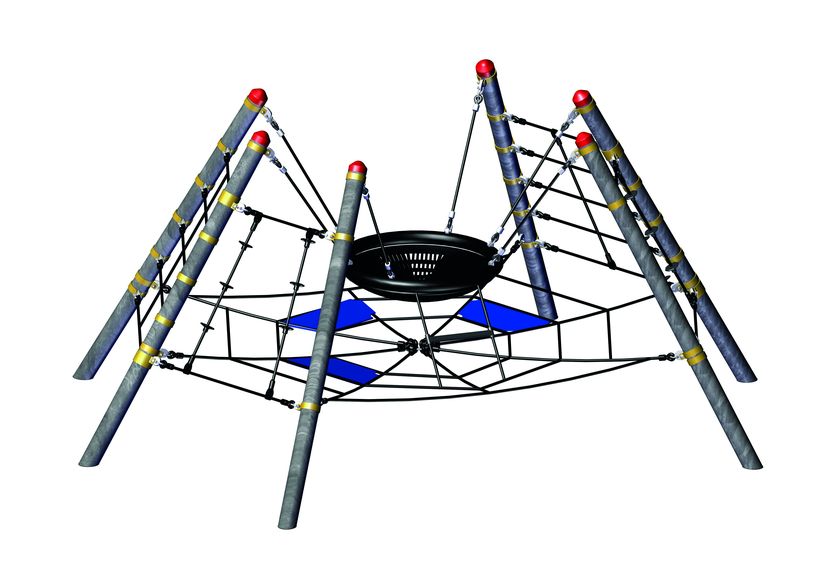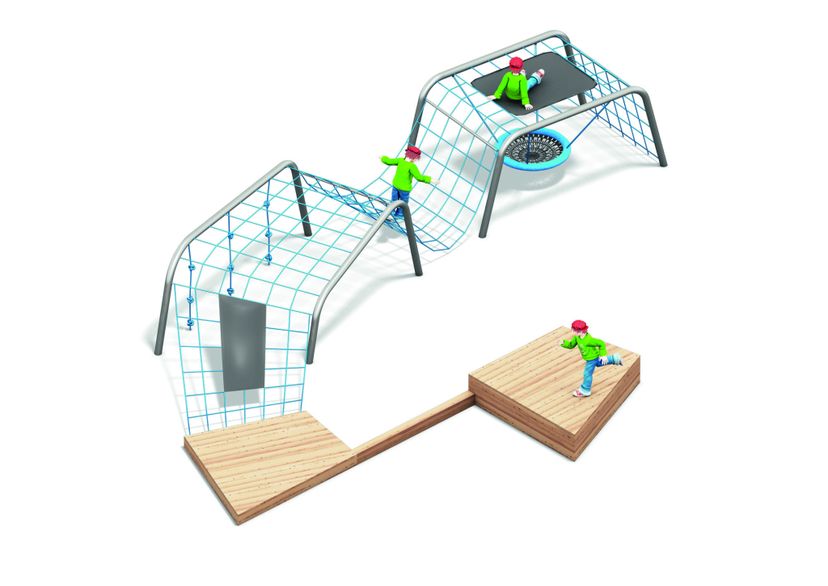How Children Play at Different Ages & Stages of Development
During the design process of your playground project, it's important to consider how children play at different ages. Toddlers tend to observe or play alongside others, while older children prefer collaborative, social playtime. The playground structures you choose should match these needs.
To help your design process, we've broken down the ways children play in early childhood as they reach different developmental milestones and learn important skills for healthy development.
We've also included our recommendations for play structures for the different stages.
How Children Play at Different Stages of Development
Children learn new skills and behaviours as they grow in line with their developmental stage. We've put together a guide on how children play at different ages and what kind of play structures best suit their needs.
Unoccupied Play: 0-3 Months
Unoccupied play is the earliest stage of play, typically observed in infants from birth to around 3 months of age.
During this stage, babies are not yet actively engaging with their surroundings or with other people. Instead, they makeseemingly random movements with no clear purpose, which might include kicking their legs, waving their arms, or cooing.
These actions are crucial as they help infants explore their own bodies and movements, setting the stage for more complex forms of play.
Although it might not look like traditional play, unoccupied play is an important foundational behaviour that supports the development of motor skills and cognitive abilities.
|
Play Structure Recommendations:
|
Solitary Play: 0-2 Years
Solitary play, also known as independent play, typically occurs from birth to around two years of age. During this stage, children play alone and are engrossed in their own activities without much interest in or awareness of others around them.
This type of play allows children to explore their environment at their own pace, develop personal preferences, and enhance their concentration skills.
Solitary play is crucial for fostering independence and self-reliance, laying the groundwork for future social interactions and collaborative play.
|
This type of play includes:
|
Onlooker Play: 2 Years
Onlooker play generally starts around the age of two and is characterised by children observing other children play without directly participating themselves.
At this stage, children are highly interested in their peers' activities and can spend significant amounts of time simply watching them.
They may ask questions about the play they observe or provide commentary, but they are not yet ready to join in.
Onlooker play is a vital stage because it allows children to learn about social interactions, understand different play roles, and develop their observational and cognitive skills.
This stage is also when playgrounds can become highly beneficial. Playgrounds offer an environment where children can watch others engage in various types of play, from climbing and sliding to imaginative, creative games and cooperative group activities.
They can also engage in solitary play on age-appropriate equipment.
The diverse range of play equipment and social dynamics in playgrounds provides endless opportunities for children to learn through observation, preparing them for more direct social interactions and collaborative play in the future.
Benefits of Outdoor Play in Early Years: Supporting Our Children
Parallel Play: 2+ Years
Parallel play usually starts around the age of two and continues as children grow. During this stage, kids play next to each other without interacting directly.
Each child is focused on their own activity, but being close to their peers allows them to observe and learn through play.
In parallel play, children play independently but in the same area. They might all be building with blocks, drawing, or doing similar activities but separately.
While it may seem like they're not interacting, parallel play is important for social development. It helps children understand group dynamics and personal space, serving as a step towards more interactive social play.
By watching their peers, children pick up new skills and behaviours to use in their own play. Parallel play encourages a sense of community, preparing kids for future collaborative and cooperative play experiences.
|
This type of play includes: |
Associative Play: 3-4 Years
Associative play usually begins around ages three to four. Unlike parallel play, where kids play independently but side-by-side, associative play involves more interaction.
At this stage, children start to engage directly with each other, sharing toys and communicating, even though they might not have a common goal.
Each child is still focused on their own activity but is interested in what others are doing and may offer input or help.
In associative play, kids might be seen building blocks, discussing their creations, or role-playing.
This stage is crucial for developing social skills, as itencourages communication, cooperation, and the beginning of understanding others' perspectives. It helps children learn how to negotiate and take turns, preparing them for more complex cooperative play in the future.
Playgrounds can greatly enhance associative play by offering various opportunities for kids to interact. This shared play experience promotes emotional and social development, paving the way for lasting friendships and teamwork.
|
This type of play includes:
|
Cooperative Play: 4+ Years
Cooperative play is the most advanced form of social play and usually starts around the age of four. In this stage, children play together towards a common goal, often sharing ideas and coordinating their actions.
This might include building a structure with blocks as a group, playing team sports, or engaging in pretend play that requires collaboration, like acting out a story.
During cooperative play, children develop important social skills such as communication, teamwork, problem-solving, and empathy.
They learn to negotiate roles, share responsibilities, and resolve disagreements, which are crucial skills for later in life.
This type of play not only improves their cognitive and motor skills but also fosters a sense of community and belonging among peers.
Playgrounds are perfect for cooperative play because they offer various equipment and spaces that encourage group activities.
|
This type of play works on structures designed for multiple users, like:
|
Huck Play Playground Structure Recommendations By Age
The type of play structures you put in your playground project will be guided by the age of the children who are going to be using the equipment.
For example, the equipment in a nursery playground will be smaller and simpler than equipment for primary school or community playgrounds.
Here are some suggestions for playground equipment broken down into age groups.
Onlooker & Parallel Play Equipment – Age 2+
When building a playground for younger children, it's important to make sure your structures are facilitating onlooker and parallel play that's appropriate for this age group.
Our Toddler Swing Seat is a great example of parallel or onlooker play. Made with our iconic Hercules steel core rope, this colourful swing allows children to observe others and play alongside their peers.
The "Fortuna" Mini Pirate Tower is the perfect centrepiece for a nursery playground that allows children aged 2+ to play alongside each other when taking different routes to the top.
The bird's nest provides a space for curious minds to sit, rest, and observe children around them.
Associative Play Equipment – Age 3+
If you're building a community park or have children aged 3+ in a nursery playground, a good design will benefit from having associative play equipment to help older children continue to develop and hone their social skills.
Our top recommended play structure for children over 3 years old is the Tarantula. This structure can accommodate up to 11 children at a time and provides plenty of opportunities for associative play.
The Mini Pirate Tower is the ideal themed structure to encourage children aged 3+ to engage in associative play.
This large structure can accommodate up to 15 children who can play independently but also associate with each other, taking turns climbing the ladder or using the swing. They can even play pirate-themed role-playing games!
Cooperative Play Equipment – Age 6+
For community and primary school play areas, the focus should shift primarily to play equipment that facilitates cooperative play. This means structures and equipment that require more than one child to work properly.
One of our favourite pieces of cooperative play equipment is the Rubber Jumper. This unique piece of equipment is like a cross between a see-saw and a trampoline, requiring between 2 and 18 children to bounce higher.
Our Serpent - The Snake structure features balance beams, climbing nets and our Huck Original Bird's Nest swing, providing plenty of opportunities for children to play cooperatively and imaginatively with each other.
With room for up to 35 children, this structure is ideal for schools and communities.
How to Get ‘Free’ Playground Equipment With Funding & Grants in the UK
Build An Age Appropriate Playground With Huck Play
At Huck Play, we offer a variety of rope-based play structures catered to different age groups, ensuring that your playground is both age-appropriate and stimulating.
With our expertise, we can help design and build a playground that supports developmental milestones, from associative play to cooperative and imaginative play.
As the country's leading rope-based play equipment manufacturer, our durable, safe, and engaging equipment ensures children get the most out of their playtime, fostering essential skills and behaviours as they grow.
Contact us today to find out how we can help bring your playground project to life.
FAQs
Catering to stages of play is crucial as it supports children's developmental milestones. Each stage enhances specific skills such as motor, cognitive, social, and emotional abilities. Age-appropriate equipment ensures safe, stimulating play that encourages growth, learning, and the foundation for future social interactions. While older children can play on equipment meant for younger kids, it may not fully engage their abilities or interests. For safety and optimal developmental benefits, it is recommended that children use age-appropriate structures tailored to their physical and cognitive skills. Kids typically start playing with each other during the associative play stage, which begins around ages three to four. During this stage, they start to engage directly with their peers, sharing toys and communicating, even though they may not have a common goal. Yes, our play structures are designed to encourage motor skills. They offer varied physical challenges like climbing, balancing, and swinging, which enhance both fine and gross motor skills. This helps children develop strength, coordination, and agility in a fun and engaging way.Why is Catering to Stages of Play Important?
Can Older Children Play on Structures Designed for Younger Age Groups?
What Age Do Kids Start Playing With Each Other?
Do Your Play Structures Encourage Motor Skills?


